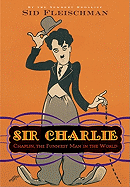
This biography of a consummate showman seems a fitting swan song for Sid Fleischman, the self-proclaimed Abracadabra Kid who died in March. Fleischman's background as a magician and screenwriter places him in a unique position to capture Charlie Chaplin (1889-1977), a comic genius with impeccable timing and "a master of pantomime and physical comedy," according to the author.
Chaplin's rags-to-riches story shares much in common with Harry Houdini and Samuel Clemens, Fleischman's other recent biography subjects. (The author makes the comparison: "Like Houdini freeing himself from a straitjacket, [Chaplin] escaped his ordained captivity in the London slums.") Because Chaplin's mother struggled with insanity, Charlie and his brother, Sydney, were sent to the Hanwell Schools for Orphans and Destitute Children. But, as the author states, Chaplin "would never forget how quickly laughter and tears changed places.... As if privy to a great secret, he built his greatest comedies on it." In Chaplin's first feature-length hit, The Kid, a child is shipped off to an orphanage. "What's so funny about that?" writes Fleischman, "Trust him." We also gain insight into the economics of silent films of that era; the Keystone Studio's "clam-tight economies," in which "the first shot became the last shot" in front of the camera; and Chaplin's subsequent decision to go out on his own. His ability to mine the most sinister of topics (such as the backyard ovens of his 1946 film Monsieur Verdoux) and lace them with humor won him critical acclaim, while his Little Tramp's struggles allowed him inside the hearts of the Everyman. Fleischman's deft turns of phrase conjure all the wit of his onscreen hero: "At age twenty-seven, the penniless tramp had made Chaplin a millionaire." The author chronicles the controversy surrounding Chaplin's marriages to "such young women" and suspicions raised during the House Un-American Activities investigations, and his eventual deportation. Generous film stills and copious endnotes make this an invaluable resource for those of all ages interested in Chaplin, history or filmmaking. From his pauper beginnings to his grave-robbed end, this portrait of Chaplin emerges as colorfully and captivatingly as only Fleischman could render him.--Jennifer M. Brown

